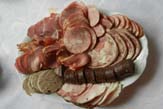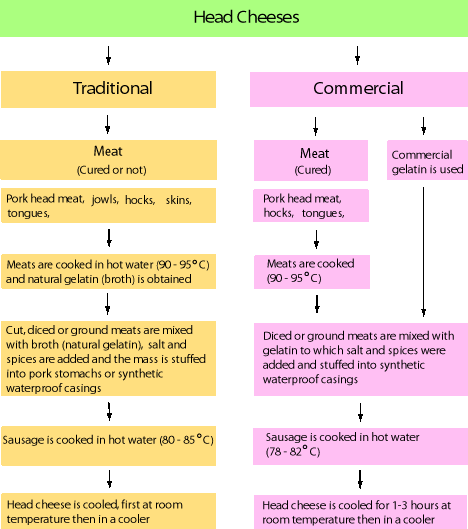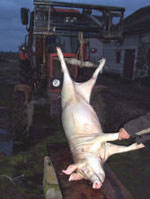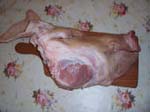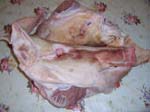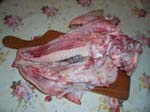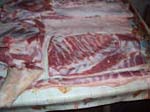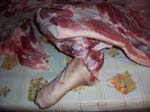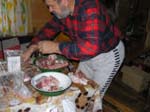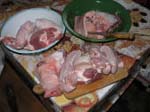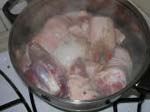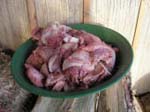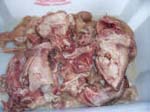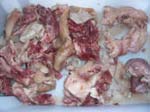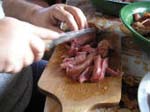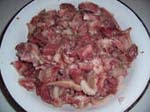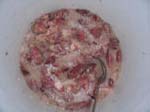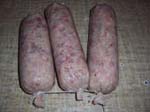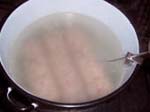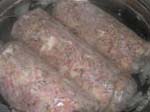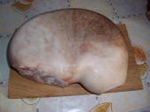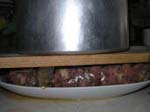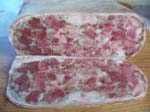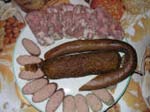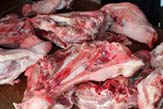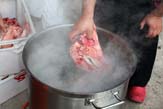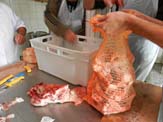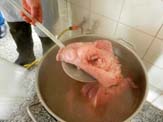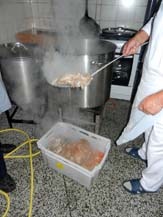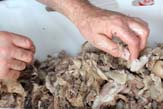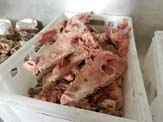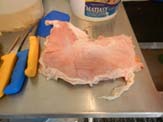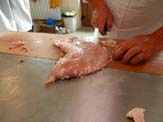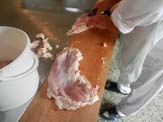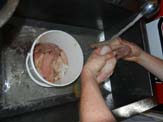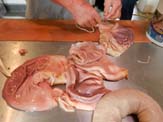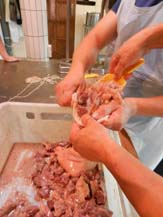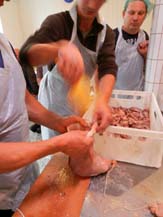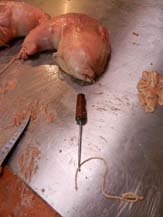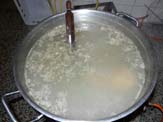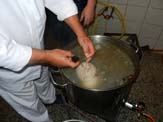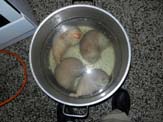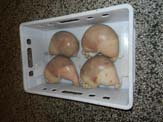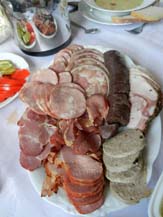Meats and Sausages
Head Cheese
Traditionally head cheese was made entirely from the meat of the head of a hog, cured and stuffed in large beef bungs or in pork stomachs. We may find this choice of meat today less appealing, forgetting at the same time the fact that pork head meat is highly nutritional and flavorsome. Do not confuse head meat with brains. Bear in mind that the head is boiled first until the meat easily separates from the bones and then it looks like any other meat. Persons living in metropolitan areas cannot buy pork head anyhow but still can make a great-tasting product by using pork picnic and pigs feet. Nowadays, head cheese can include edible parts of the feet, tongue, and heart.
In English, the name head cheese doesn't sound appealing, and it prevents many people from trying the product. In other languages, it is called in a friendlier manner, without the word “head” being part of the name. When vinegar is added, it is called “souse”, and this already sounds much better. Head cheese, brawn, or souse are not cheeses but rather jellied loaves or sausages that may or may not be stuffed into the large diameter casing. They can be easily found in places that cater to Central Europeans, Eastern Europeans, and Italians, as well as in Spanish-speaking countries..
Many of us have made a head cheese before without even realizing it, although pork head meat was not a part of the recipe. Every time we cook meat stock or chicken soup based on bones, we are making a weak version of a head cheese. The reason the soup does not become a meat jelly (aspic) is because there is too much water in it.
If this stock would simmer for a long time, enough water would be lost, and the resulting liquid, when cooled. would solidify and become a jelly. In the past, after the first and second World War, or even in most countries today, people had no opportunity to buy commercially made gelatin. And this is why those unappealing cuts of meat like pork head, jowls, skins, hocks, legs and fatty picnic legs started to shine as they can produce a natural gelatin.
You cannot make the real head cheese by using noble cuts like hams, loins or other tender lean meats. Those expensive cuts don’t contain enough connective tissues (collagen) in order to make natural gelatin. You can use them, but a commercial grade gelatin must be added and of course the taste and flavor of the finished product will be less satisfactory, although the resulting jelly will be very clear. Making head cheese is quite easy as the procedure does not involve the use of special equipment like a grinder or stuffer. Every kitchen contains all the utensils that are needed.
Types of Head Cheeses
- Regular head cheese - pork head meat, jowls, skins, snouts, pigs feet, gelatin.
- Tongue head cheese - in addition to the above-mentioned meats, the tongue added. It should be cured with salt and nitrite in order to develop a pink color.
- Blood head cheese - head cheese made with blood. Such a head cheese is much darker in color.
- Souse - a typical head cheese to which vinegar has been added. Similar to sulz but not limited to pig’s feet only. Most people eat head cheese with vinegar or lemon juice anyway so it comes as no surprise that vinegar would be added to head cheese during manufacture. It also increases the keeping qualities of the sausage as all foods containing vinegar last longer. Souse contains more jelly than a regular head cheese. In addition, pimentos, green peppers, or pickles are often added for decoration. Both sulz and souse contain about 75% of meat, 25% of jelly, and around 3% of vinegar.
- Sulz - original head cheese made of pigs feet with the bone in. Later bones were removed to facilitate slicing. This name can be found in some older books. It was made with pig’s feet only but often snouts and pig skins were added as well. Meat jellies made from pig’s feet are still popular in many European countries, for example, in Poland where they are known as pig’s feet in aspic ( Nóżki w Galarecie). Pickled pig feet, which are sold today are basically sulz in vinegar.
Head cheese, souse and sulz are all very similar, the main difference is that souse and sulz contain vinegar and more gelatin.
Manufacturing Process
Meat Selection
Traditionally made head cheese requires meats with a high collagen content to produce a natural gelatin. Anybody can buy commercial gelatin, mix it with water, and create jelly. However, such a jelly has no taste at all and is a poor imitation of a naturally produced meat stock. Meat cuts such as pork head, hocks and skins are capable of producing a lot of natural gelatin as they contain a lot of connective tissue that will produce gelatin. Tongues, hearts, snouts, ears and skins are also used as filler meats. Commercially made products don’t depend on natural gelatin and use commercially produced gelatin powder instead. Natural gelatin is made from bones (pork and beef) and skins. Before meats are submitted to cooking in water a decision has to be made whether the meats will be cured or not. Commercial producer will invariably choose to cure meats with nitrite in order to obtain a typical pink color.
Meats that were traditionally used for head cheeses were:
- Pork heads (cured or not), often split in half - boiled in hot water at about 194º F (90º C) until meat is easily removed from bones by hand. They should be first soaked for 1-2 hours in cold water to remove any traces of coagulated blood.
- Pork hocks (cured or not) - boiled at about 194º F (90º C) until meat is easily removed from bones by hand.
- Skins - pork skins should be clean without any remaining hair or excess fat. They are cooked at 185-194º F (85-90º C) until soft. This may require a longer cooking time. Pork shanks with meat (picnic), cured or not - boiled in hot water at about 194º F (90º C) until soft.
- Lean pork trimmings (cured or not) - boiled in hot water at about 194º F (90º C) until soft.
- Hearts (cured or not) - boiled in hot water at about 194º F (90º C) until soft. Hearts are first cut open and any remaining blood is rinsed away in cold water. The heart is a very hard working muscle and will be of a dark red color due to its high content of myoglobin. It should be diced into small diameter pieces (1/4”, 5-6 mm), otherwise it will stand out.
- Tongues (cured or not) - boiled in hot water at about 194º F (90º C) until soft. Pork or beef tongues are very often used but the outer skin on the tongues must be removed due to its bitter taste. It is easily accomplished once the tongues are submerged for a few minutes in hot water.
Looking at the above-listed meats it i,s easy to conclude that a person living in a large city should not face any difficulty in making a head cheese. Some substitutions need to be made as pork heads will not generally be available, but tongues or even hearts are frequently seen in supermarkets. Instead of using unusual and fatty cuts of the hog (head), which may be available only at specialty butcher stores, similar results could be obtained by using other meats and gelatin. Picnic (lower front leg) and pork butt are common items and will make a great head cheese. Picnic, hocks, and feet are rich in connective tissue and will produce a lot of gelatin.
A meat plant or a farmer will have access to traditionally used cuts of meat:
It is what you know that counts when making superior products
A great product can be made at any conditions and not the amount of space or latest equipment is needed but the knowledge of the subject and sensible work organization as is being demonstrated by Mr. Kruszynka in the photos below, who makes wonderful products in his little kitchen.
Curing Meats
Traditionally made products may employ meat curing with nitrite or not. If meats are not cured with sodium nitrite the product will be of grey color. Curing pork heads or legs is a hassle that requires extra space in a cooler, dedicated containers, and additional time.
Head cheeses are not smoked so there is very little need for sodium nitrite, at least for safety reasons. A commercial producer will cure meats as he is mainly concerned with profit. The product must look pretty and must have a long shelf life, otherwise supermarkets will not carry it. As a customer judges a healthy-looking meat product by its red or pink color (poultry meat is an exception), the commercial producers cure meats to get this pink. Another incentive for a commercial plant to cure meats is that they gain weight and that leads to increased profits.
Cutting Meats
The grinder is usually not employed as this will extract proteins and will break the fat’s structure. As a result, a cloudy stock will be obtained. Meats are much easier to cut into smaller pieces when chilled. After they are cut, it is a good idea to rinse them briefly in hot water as this will eliminate unnecessary grease that would normally cloud the jelly. Until now, the process of making head cheese or meat jelly has been the same. What differentiates them is that head cheese being sausage, is stuffed into casings, and meat jelly is not.
Cooking Meats and Making Broth
This is basically one easy process but certain rules must be observed. Head cheese differs from other sausages in that meats are cooked before stuffing:
- All meats, skin included, are cooked until soft.
- Meat is separated from bones.
Meats should be covered with 1-2 inches of water and simmered below the boiling point for 2-3 hours. Boiling water will produce a cloudy stock. The skins should be boiled separately until soft but still in one piece. When still warm, cooked meats should be removed from bones and cooled down. The skins are cut into strips. The resulting meat broth should be filtered though 2-3 layers of cheese cloth until clarified. The better clarity obtained, the better looking cheese head will be produced. Such a jelly is fat-free and rich in protein product.
When too much water is used, a broth may contain not enough gelatin and will not set. This becomes a serious issue if the meat is already stuffed into the casing, The problem can be corrected by additional boiling of the meat stock. As more water evaporates from the stock, the resulting meat broth gets concentrated and, when cool, should become a jelly. If this does not work, you need to re-heat the aspic (jelly), pour the hot broth through a strainer, and add a packet of commercial gelatin. Then re-arrange meats on a plate and pour the new gelatin over them.
When in doubt, it is safer to add powdered gelatin straight from the beginning than to create unnecessary extra work. As an extra precaution you may test your meat broth before it is added to the casing. Place some of it in a refrigerator and see whether it solidifies within one hour. If not enough collagen is present, for example, too much lean meat is selected, little gelatin will be produced, and the resulting meat stock will not solidify. This can be easily corrected by adding commercial gelatin. For the best flavor, mix powdered gelatin with the existing meat broth and not with water. Water will dilute the flavor of the broth.
Mixing
Meats are mixed with all other ingredients. Although the recipe provides the amounts of all ingredients, nevertheless due to precooking meats in water and then washing them with hot water later on, it is recommended to taste the mixture and refine the recipe if needed. Do not mix meat with hot broth together before stuffing. The hot jelly will draw some of the juices out of the meat, and the jelly becomes cloudy. A good idea is to scald meat with hot water to remove any grease that might cloud the gelatin.
Stuffing
Head cheese was traditionally stuffed into pig stomach. The pig stomach is a one-unit chamber of uniform oval shape with two easy-to-saw openings. The stomachs of a cow or a sheep are basically three-chamber units. The shape of those stomachs is irregular and not easy to fill. After filling, the stomach's opening had to be sewn with butcher's twine. Today, head cheese is stuffed into a large diameter synthetic casing, preferably a plastic one that will prevent loss of aspic during cooking. The tied or clipped at the bottom casing is held vertically and meat pieces are placed first. Then gelatin, from naturally produced meat broth or made from a commercial grade, is carefully poured down into the casing. This is normally done through a big funnel using a ladle. The casing is tied or clipped on the top and the head cheese is ready for cooking.
Cooking Head Cheese
Cooling Head Cheese
After cooking, head cheese should be left at room temperature for a few hours to let the steam out. After that, the head cheese is placed between two wooden boards. The top board is weighted and the sausage is stored overnight in a cooler. This permanently flattens the head cheese and gives him a rectangular shape with rounded corners.
Head cheeses stuffed into round fibrous casings are not flattened.
Ingredients and Spices
Amount of salt varies between 1.5-2% which is the same as for a typical sausage. Commonly used spices are pepper, nutmeg, mace, allspice, cloves, marjoram, cardamom, onions, garlic, caraway, thyme, ginger.
Notes
Head cheeses, liver sausages and blood sausages belong to a special group of products that incorporate less noble cuts of meat that will be much harder to sell to the public at least in their original form. What separates those products from other common sausages is the fact that meats are precooked before being stuffed into casings, and then they are submitted to a hot water cooking process. Another peculiarity is that all those products are often made without being stuffed into casings:
- When placed in forms and baked in the oven, liver sausages become pates.
- When placed in forms and baked in the oven, blood sausages become blood puddings or blood meat patties.
- When placed in forms and allowed to cool, head cheeses become meat jellies.
Traditionally made head cheese or meat jelly may look less pretty but will be a product of much higher quality due to the following reasons:
- No chemicals added
- No water pumped into the product (stronger, meatier flavor)
- Natural broth (no gelatin added). Commercially prepared gelatin is a combination of neutrally flavored powder and water, but the natural broth (aspic) is a highly flavored meat stock that remains after cooking meat with bones. Such meats are rich in connective tissue, which contains plenty of collagen. During heat treatment, this collagen becomes liquidified gelatin. Upon cooling, this gelatin solidifies becoming aspic (jelly), which binds meats and ingredients together. The aspic accounts for about 30% of the total weight of the product. What would you prefer to have in your head cheese or meat jelly: 30% of water with powdered gelatin or 30% of pure meat broth?
Many people limit themselves to making just one or two types of sausages (fresh or smoked variety) and mistakenly believe that special sausages (liver, blood, or head cheese) must be very complicated to make. Yet a head cheese is a very simple product to make as long as one forgets he is making a sausage and starts to think in terms of cooking a hearty meat broth. When the broth is cooked, all that remains is to separate meats from bones and stuff them in a large diameter casing or place them to cool in any kind of a food-grade container.
Commercial processors like to add some wine or vinegar to create a slightly sour flavor, as this will extend the shelf life of the product. Most homemade head cheeses don't contain vinegar or wine in their composition. Head cheese is consumed cold and freezes very well.
Final Note
If head cheese is such a great product why is not commonly available? Well, the manufacturing process is more complicated as it requires precooking meats and separating them from bones. The process becomes time-consuming and requires more equipment. As a result, the processors will have to charge a steep price to break even. It is more profitable to make a sausage than a head cheese. Secondly, American consumer knows less about head cheese or blood sausage than their European counterpart. We may eat a lot of sausages in the USA, but they are mainly hot dogs, bologna, and fresh sausages that will be grilled.

